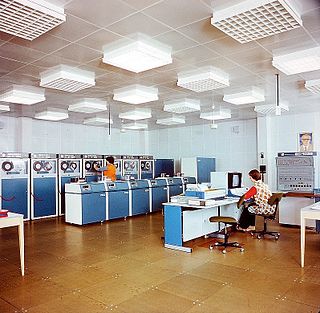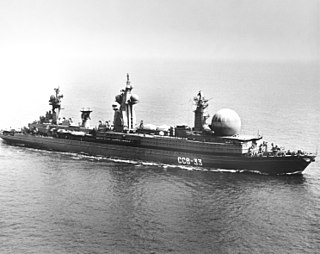Andrey Petrovich Yershov was a Soviet computer scientist, notable as a pioneer in systems programming and programming language research.
BESM (БЭСМ) is the series of Soviet mainframe computers built in 1950–60s. The name is an acronym for "Bolshaya Elektronno-schotnaya Mashina", meaning "Big Electronic Computing Machine" or "High-Speed Electronic Computing Machine". It was designed at the Institute of Precision Mechanics and Computer Engineering

Mount Elbrus is the highest and most prominent peak in Russia and Europe. It is situated in the western part of the Caucasus and is the highest peak of the Caucasus Mountains. The dormant volcano rises 5,642 m (18,510 ft) above sea level; it is the highest stratovolcano in Eurasia, as well as the tenth-most prominent peak in the world. The mountain stands in Southern Russia, in the Russian republic of Kabardino-Balkaria.

The Elbrus is a line of Soviet and Russian computer systems developed by the Lebedev Institute of Precision Mechanics and Computer Engineering. These computers are used in the space program, nuclear weapons research, and defense systems, as well as for theoretical and researching purposes, such as an experimental Refal and CLU translators.
Mount Elbrus is the highest mountain in Russia and Europe.

BESM-6 was a Soviet electronic computer of the BESM series. It was the first Soviet second-generation, transistor-based computer.

The ES EVM, or YeS EVM, also known in English literature as the Unified System or Ryad, is a series of mainframe computers generally compatible with IBM's System/360 and System/370 mainframes, built in the Comecon countries under the initiative of the Soviet Union between 1968 and 1998. More than 15,000 of the ES EVM mainframes were produced in total.

Sergey Alekseyevich Lebedev was a Soviet scientist in the fields of electrical engineering and computer science, and designer of the first Soviet computers.

Boris Artashesovich Babayan is a Soviet and Russian computer scientist of Armenian descent, notable as the pioneering creator of supercomputers in the former Soviet Union and Russia.

SSV-33 Ural was a command and control naval ship operated by the Soviet Navy. SSV-33's hull was derived from that of the nuclear powered Kirov-class battlecruisers with nuclear marine propulsion. SSV-33 served in electronic intelligence, missile tracking, space tracking, and communications relay roles. Due to high operating costs, SSV-33 was laid up in 1989.

Lev Nikolayevich Korolyov was a Russian / Soviet computer scientist, a corresponding member of the USSR Academy of Sciences. He was involved in the development of the first Soviet computers.

The R-17 Elbrus, GRAU index 9K72 is a tactical ballistic missile, initially developed by the Soviet Union. It is also known by its NATO reporting name SS-1C Scud-B. It is one of several Soviet missiles to carry the reporting name Scud; the most prolifically launched of the series, with a production run estimated at 7,000 (1960–1987). Also designated R-300 during the 1970s, the R-17 was derived from the R-11 Zemlya. It has been operated by 32 countries and manufactured in four countries outside the Soviet Union. It is still in service with some. It's been called the Hwasong-5 in North Korea.

MCST is a Russian microprocessor company that was set up in 1992. Different types of processors made by MCST were used in personal computers, servers and computing systems. MCST develops microprocessors based on two different instruction set architecture (ISA): Elbrus and SPARC. MCST is a direct descendant of the Lebedev Institute of Precision Mechanics and Computer Engineering.

Astra Linux is a Russian Linux-based computer operating system (OS) that is being widely deployed in the Russian Federation in order to replace Microsoft Windows. Initially it was created and developed to meet the needs of the Russian army, other armed forces and intelligence agencies.

Vladimir Mstislavovich Pentkovski was a Soviet-American computer scientist, a graduate of the Moscow Institute of Physics and Technology and winner of the highest former Soviet Union's USSR State Prize (1987). He was one of the leading architects of the Soviet Elbrus supercomputers and the high-level programming language El-76. At the beginning of 1990s, he immigrated to the United States where he worked at Intel and led the team that developed the architecture for the Pentium III processor. According to a popular legend, Pentium processors were named after Vladimir Pentkovski.

The history of computing in the Soviet Union began in the late 1940s, when the country began to develop its Small Electronic Calculating Machine (MESM) at the Kiev Institute of Electrotechnology in Feofaniya. Initial ideological opposition to cybernetics in the Soviet Union was overcome by a Khrushchev era policy that encouraged computer production.
El-76 is a high-level programming language developed in 1972–1973. The language was created for the Elbrus computer. Participants in the creation of the language were: Boris Babayan, V. M. Pentkovskii, S. V. Semenikhin, S. V. Veretennikov, V. Y. Volkonsky, S. M. Zotov, A. I. Ivanov, Y. S. Rumyantsev, V. P. Torchigin, M. I. Kharitonov, and V. S. Shevekov.

The PS-2000 was a Soviet supercomputer built in the 1980s.














